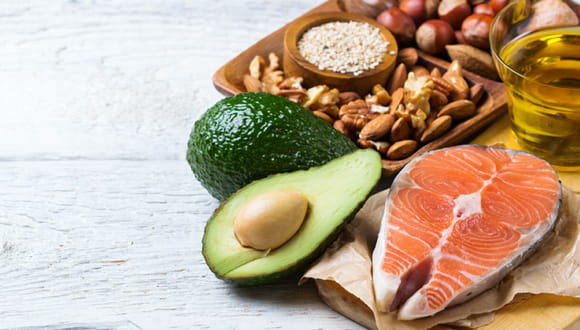Let’s face it: Finding healthy food options can be challenging. Even when you’re surrounded by what seems to be healthy choices, one of the easiest sections of a nutrition label to get stuck on is “Total Fat.”
It’s no secret that a gram of fat has more than twice as many calories than its protein and carbohydrate counterparts. Then there’s the alphabet soup of types of fat you find on a nutrition label. Trans fats, saturated fats, monounsaturated fats, polyunsaturated fats — which ones are healthy, again?
“When it comes to dietary fats, it’s the type of fat and the amount consumed that matter most,” says Nathalie Sessions, wellness dietitian at Houston Methodist Wellness Services.
The skinny on fats
Fats may be calorie dense, but they’re also an essential part of your diet. So much so that experts recommend that 20 to 30% of your daily calories come from fats.
“Without enough fat, the body has trouble absorbing important vitamins, such as vitamin A, D, E and K. Fat also helps you feel full after eating and contributes to energy production,” says Sessions.
The four types of fat you’ll find in food are:
- Trans fats
- Saturated fats
- Monounsaturated fats
- Polyunsaturated fats
All fats play a role in keeping your body functioning, but some are better for you than others. Trans fats are manufactured and unhealthy, and should be avoided as much as possible. But what about the other three?
Try to limit saturated fats
Saturated fats aren’t as bad for you as trans fats, but most health authorities agree that they’re not really good for you, either. The American Heart Association recommends that saturated fats make up no more than 6% of the calories you eat every day, which is 13 grams of saturated fat if you’re following a 2,000-calorie-a-day meal plan.
How to avoid saturated fats
Saturated fats are found in foods such as red meat, milk, dairy products (including butter and cheese), baked or fried goods and many packaged snacks. According to the 2006 National Health and Nutrition Examination Survey, the most common sources of saturated fats in the U.S. are:
- Cheese
- Pizza
- Grain-based desserts
- Dairy desserts
- Chicken and chicken-based dishes
- Sausage, bacon, hot dogs and ribs
- Burgers
Choose protective unsaturated fats instead
Monounsaturated fats and polyunsaturated fats are healthy fats. For instance, both monounsaturated and polyunsaturated fats help lower your bad cholesterol (or LDL) and boost your good cholesterol (HDL), lowering your risk for heart disease.
When it comes to making healthy choices about fat, it’s best to replace saturated and trans fats with monounsaturated and polyunsaturated fats. The nutrition label on packaged foods usually defines the amount of monounsaturated and polyunsaturated fats (if there are any) per serving.
Foods rich in monounsaturated fats:
- Avocados
- Oil-based salad dressings
- Nuts, such as almonds, peanuts and pecans
- Olives and olive oil
- Seeds, such as pumpkin and sesame seeds
- Some cooking oils, such as canola, peanut and safflower oils
Monounsaturated fats are also a great source of vitamin E, which is important for your vision, brain and skin. Vitamin E also has antioxidant properties. (Related: Is Avocado Toast Actually Healthy?)
Foods rich in polyunsaturated fats:
- Fish, such as salmon, trout and tuna
- Oil-based salad dressings
- Nuts, such as pine nuts and walnuts
- Seeds, such as flax, pumpkin, sesame and sunflower seeds
- Some cooking oils, such as corn oil
Two types of polyunsaturated fats, omega-3 and omega-6, are considered essential fats. This means that your body can’t make either of these fats, so it’s important that you get them through your diet.
All fats are high in calories, so watch your portion size — but don’t try to eliminate them from your diet either.
“The key is to go for healthy fats in moderation,” says Sessions. “While dietary fat has more fat compared to carbohydrates and protein, excess intake of calories from any food group is what leads to weight gain.”


